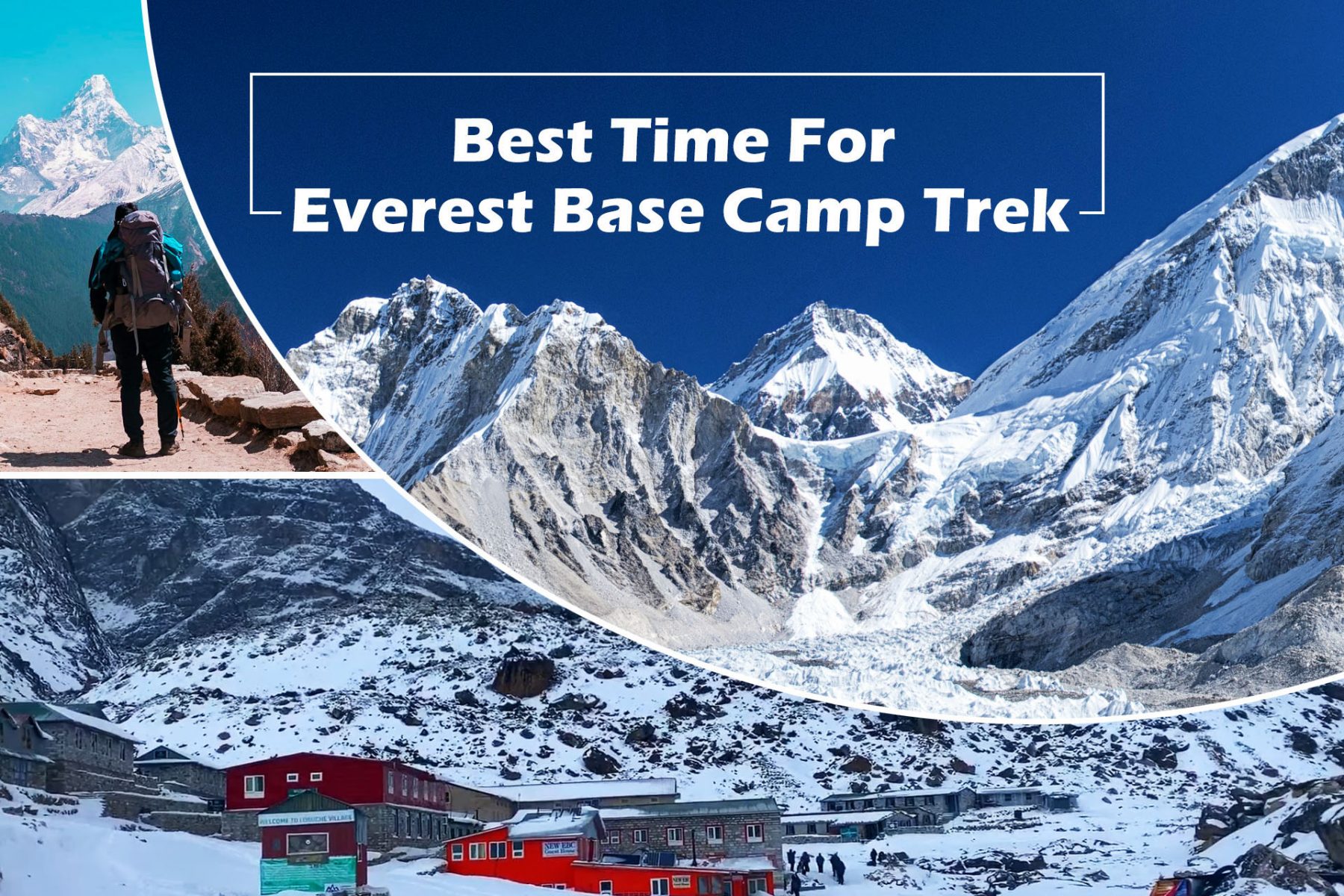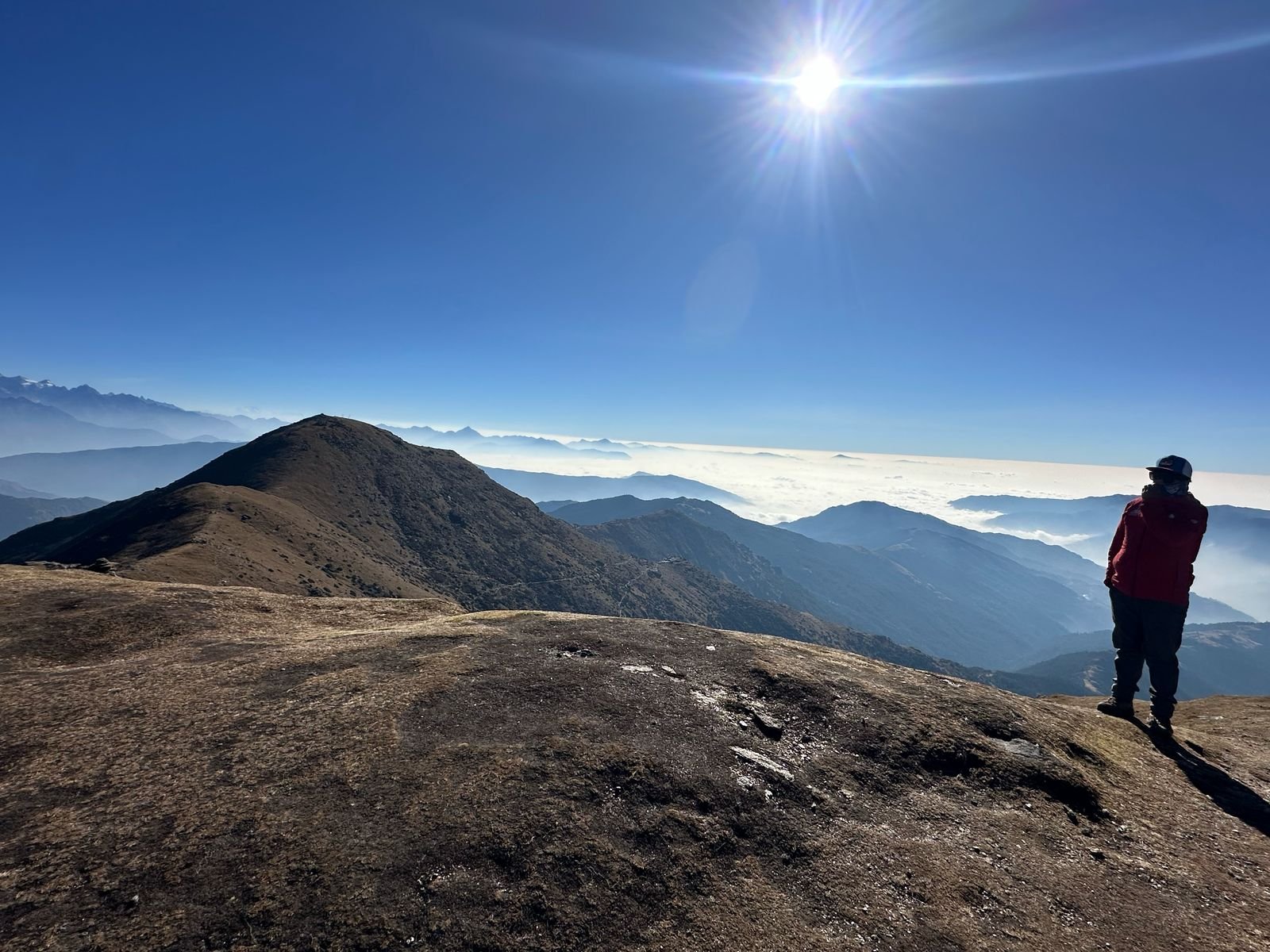Best Time for Everest Base Camp Trek

Best Time for Everest Base Camp Trek
What is the best time for the Everest Base Camp Trek? If you are planning to do the Everest Base Camp Trek, this question will naturally arise in your mind. You are at the right place if you think about the best time.
Mount Everest (8,848 m) attracts trekkers with its awe-inspiring charm. So, the Everest base camp trek is the dream trek of many trekkers. The EBC trek is one of the top three trekking destinations in the world, with the most spectacular mountain views. Mt. Everest is in the Khumbu region, most famous for trekking in Nepal.
Trekkers can get a perfect view of many stunning Himalayan peaks. This trek is also famous for the Khumbu glaciers, Khumbu Icefall, beautiful landscapes, Tibetan Sherpa culture, and ancient Tibetan monasteries. Kala Patthar, the Sherpa people, Ama Dablam Peak, Island Peak, and Sagarmatha National Park are more attractions of this trek.
Everest Base Camp Trekking is an adventure of a lifetime, so knowing the right time to trek is essential. Choosing the right time gives you a great view and experience that will last a lifetime. Trekking at the best time offers clear views of the Himalayan range, glaciers, farmlands, villages, and clear blue skies.
In this blog post, we discuss the weather conditions in the Everest region and the trekking seasons. This information will help you decide when to trek to Everest Base Camp. The Himalayas have notoriously harsh weather, so treks to Everest Base Camp should only be done at certain times of the year.
The best time for Everest Base Camp trekking also depends on various factors, including weather, personal preferences, and physical fitness. Generally, spring and autumn are the best and most recommended times to trek to Everest base camp. Here’s a breakdown of each season:
Spring season

The spring season usually includes the months of March, April, and May. It is a perfect time to visit Everest Base Camp (EBC). The weather during this season is generally clear and stable, with warm temperatures and less rainfall than other seasons. The trails are lined with blooming rhododendrons, making the landscape vibrant and colorful. Some key points about trekking to Everest base camp in the spring:
Weather Conditions:
Since spring starts after winter, the beginning of spring is a bit cold and gradually warms up. The weather in spring is usually mild and stable, with clear skies and minimal rainfall. Spring is the dry season for trekking in the Everest region. However, occasional rain or snow may occur, especially at higher altitudes. But rainfall is generally minimal compared to other times of the year.
Daytime temperatures can range from 10°C to 20°C (50°F to 68°F) at lower elevations but vary widely at higher elevations. Nighttime can still be cold, especially at higher elevations. At high altitudes, temperatures can drop below freezing, so it’s important to pack the essentials to stay warm.
Visibility:
Stable weather, clear skies, and minimal rainfall in the Everest region characterize spring. The sky is clear in spring, which offers excellent visibility and breathtaking views along the trekking route. The absence of clouds allows for stunning views of Mount Everest and other iconic peaks. Excellent visibility makes it ideal for photography enthusiasts. Clear visibility also enables the trail to be easily navigated, making the trip safer and more enjoyable.
Trail Conditions:
Trails are generally dry, although some higher sections may still have remnants of snow or ice. However, trail conditions are more favorable in the spring than in winter. Dry and stable trail conditions generally make trekking more accessible and enjoyable. Some parts of the trail can be muddy, especially in the lower parts or where there is water. Use trekking poles to help stabilize and navigate muddy parts of the trail.
Crowd:
Many trekkers choose this time for trekking because of the favorable weather. Therefore, spring is one of the busiest seasons for Everest base camp trekking. Most teahouses and lodges along the trail can be crowded, so it is advisable to book accommodations in advance. During this peak season, trekkers may need to be patient and flexible when looking for a place to stay. Sections with narrow trails or steep climbs can be busy, so use caution and practice trail etiquette to navigate safely.
Flora and Fauna:
The Everest base camp trek in spring offers a vibrant display of flora and fauna. Rhododendrons and other wildflowers, which bloom in pink, red, and white, bring new life to the area. It is an excellent time to catch a glimpse of Himalayan birds and mountain animals. The biodiversity and beauty of this region make it a truly unforgettable experience for nature enthusiasts.
Autumn season

Autumn (fall season) is another popular Everest base camp trekking season. This season is also the best time for the EBC trek. Autumn includes September, October, and November. Autumn is often the best and least risky time for trekking and adventure. This time offers fantastic scenery, comfortable weather, and a memorable adventure among the world’s highest peaks. Some key points about trekking to Everest base camp in the spring:
Stable Weather:
Autumn usually offers stable weather conditions with clear skies and minimal rainfall. Summer has ended, and winter has not yet begun, so there is less chance of encountering heavy rain or snow, making the trek safer and more enjoyable. Cool-weather, clear skies, and warm days are the main features of the autumn season.
Clear views:
Autumn’s stable weather provides excellent visibility. It offers clear views of the towering Himalayan peaks, including Mount Everest. During this time, there is less atmospheric disturbance, such as smoke, fog, or mist. This enhances visibility and allows you to appreciate the beauty of your surroundings without obstruction. You can enjoy mesmerizing views throughout the journey.
Mild Temperature:
Temperatures in the Everest region during autumn are mild and pleasant, especially during the day. The climate is neither too hot nor too cold, making trekking comfortable and enjoyable. No incessant rain or extreme temperatures will bother you as the rainy season ends. During the day, temperatures generally range from about 10°C to 20°C (50°F to 68°F) at lower elevations. However, temperatures can drop significantly at higher altitudes, especially at night, so you need to be prepared.
Beautiful scenery:
Autumn comes after the monsoon when the landscapes of the Everest region become lush and green. During autumn, the landscapes on the Everest Base Camp Trek route can be truly picturesque and vibrant. Vegetation regenerates, and the hills are filled with blooming, colorful flowers.
You’ll encounter a variety of flowers in the landscape, including rhododendrons and other alpine wildflowers, which add splashes of color to the scenery. Autumn is when monsoon rains fill rivers and streams, causing waterfalls to flow across the region. These waterfalls and picturesque streams add to the natural beauty of the trekking route.
Festive Atmosphere:
Nepal’s festivals are deeply rooted in its rich cultural heritage. Autumn in Nepal coincides with major Nepali festivals such as Dashain and Tihar (Diwali). While trekking during festivals, you will encounter a lively and festive atmosphere in the villages you visit. You can experience the local culture, traditions, and celebrations. Festivals also offer opportunities to capture vibrant and colorful scenes on your camera.
Monsoon (summer) season

Monsoon means the summer season, which starts in August and ends in August. It usually rains a lot during this time, so tourists are not attracted to the Everest base camp trek. It is not a travel season, as rain can cause various hazards. Summer is generally not considered the best time for the Everest Base Camp trek due to the following reasons:
Monsoon Rain:
The summer coincides with the monsoon season, which can bring heavy rainfall. The monsoon is characterized by heavy rainfall, high humidity, and cloudy skies. Heavy rains can make trekking trails muddy, slippery, and potentially dangerous. The risk of landslides also increases during this time, which poses an additional risk to hikers.
Limited visibility:
Limited visibility is a common problem in mountainous regions during the monsoon season. Heavy rain, cloud cover, and fog can significantly reduce visibility. The dense clouds obstruct hikers’ views of the surrounding landscapes.
Flight restrictions:
The monsoon often brings terrible weather conditions, making it unsafe for pilots to fly inside Lukla Airport. Clouds and fog can obscure mountainous terrain and make navigation challenging. Bad weather affects landings and takeoffs, causing most flights to be delayed or canceled. Flight delays or cancellations can disrupt entire travel plans.
Leech infestation:
Lice may increase during and after rains at lower elevations with dense vegetation. Leeches are generally harmless, but they can be uncomfortable for some hikers.
Generally, the monsoon season is considered off-season, and trekking during this time is challenging. However, you can make the trek with careful planning, flexibility, and acceptance of the challenges posed by the monsoons. But monsoon season is not recommended for a safe and enjoyable trek experience. Many hikers prefer the favorable weather conditions of spring and fall for a more satisfying and safer hiking experience.
But if you still want to trek during the monsoon, the rain-shadowed areas of the Himalayas are another option. Although many trekking areas are difficult during the monsoon season, you can trek in these areas. Upper Mustang and Dolpo are rain-show areas with very little rainfall.
Winter season

The winter season includes November, December, and January. It is not a good season to trek to Everest Base Camp. It’s not the best time to go on the EBC trek, but it’s off-season. Since it is freezing in the Himalayan region during winter, there are better choices for trekkers than this season.
Days are short, and temperatures can be extremely cold. There is a lot of snow, so routes over the big passes, like the Three Pass Trek, are usually closed. Here are some significant challenges while trekking to Everest base camp during the winter:
Cold temperature:
Temperatures around Lukla and Namche Bazaar at lower altitudes can range from 0°C to 10°C during the day. However, temperatures significantly drop at higher elevations in the mountains. At higher altitudes like Gorak Shep and Base Camp, temperatures drop below freezing. These places can often be -15°C to -20°C or even colder, especially at night.
Trekking in cold temperatures increases the risk of hypothermia and frostbite. To stay comfortable, prepare with suitable, warm clothes. Waterproof clothing with insulating layers, insulated gloves, hats, and boots are essential.
Snow and snowy trails:
Snowfall is common in the winter, covering the trekking trails with snow and ice. This can make the trails slippery and more challenging to navigate, increasing the risk of slipping. Routes may also be blocked due to snow at high altitudes. Trekkers should use trekking poles for stability and consider wearing crampons.
Increased wind speed:
Winter brings strong winds to the Everest region, especially at higher altitudes. Wind speed can vary depending on weather patterns and terrain features. However, 30–40 mph wind speeds are typical, especially in mountain passes. The combination of cold temperatures and strong winds makes the air dangerously colder than the actual temperature.
Strong winds can make trekking more challenging, especially on exposed parts of the trail. Maintaining balance and stability can be difficult when navigating rocky terrain or traversing narrow cliffs. Being prepared with appropriate clothing, gear, and knowledge of safely navigating wind conditions will make the trek safer.
Increased risk of altitude sickness:
Compared to other times, the risk of altitude sickness is higher when trekking to Everest base camp during the winter. Altitude, or acute mountain sickness (AMS), occurs when the body cannot adapt appropriately to the reduced oxygen levels at high altitudes.
Temperatures at high altitudes can be frigid, making adjusting body temperature more challenging. Hikers should follow a gradual acclimatization schedule. It’s also important to stay hydrated and be aware of the symptoms of altitude sickness to avoid serious health problems.
Limited facilities and transport options:
Winter can affect flights to Lukla, the start and end points of the Everest Base Camp trek. Trekkers should be prepared for possible delays or cancellations and have a flexible itinerary for any changes. Some tea houses along the trekking route may also be closed in winter due to a lack of visitors and the extreme cold. This means that accommodation and food options may be limited. Hikers may need to plan their itinerary carefully to ensure access to accommodation and food.
Also, consider the seasons mentioned above for these treks in the Everest region.
Everest Cho La Pass Trek: 16 Days
Everest three-pass trek: 18 days
The Everest base camp trek is challenging in winter but possible. Many trekkers have trekked even in the winter. If you are well prepared for the cold weather, winter is an excellent time to have a true adventure. It may be the best time to trek if you want to take beautiful pictures of the Everest region while enjoying the snow. Winter is also the perfect time to avoid the crowds on trekking trails.
Conclusion of best time for Everest base camp trek
There are no restrictions on trekking at Everest Base Camp at any time. With proper planning and management, you can trek anytime throughout the year. If the weather is supportive while trekking at high altitude, it will be easier to complete the trek. So, choosing the best time for the Everest Base Camp Trek is essential. Among the four seasons, spring and autumn are the best trekking seasons in Nepal, so you can plan during these seasons. The weather in spring and autumn is favorable for tourists.
So, if you plan to visit Everest Base Camp, choose spring and autumn as the best experiences. For more information about trekking and tours in Nepal, contact us at info@odysseytreksnepal.com. Odyssey Treks believes in customer satisfaction and claims to make the trip memorable, exciting, and successful.
Some charts related to the climate of the Everest region






Some frequently asked questions regarding the best time for Everest Base Camp Trek.
Q: What is the best time for the Everest Base Camp Trek?
The best time for an Everest base camp trek is usually during the pre-monsoon (spring) and post-monsoon (autumn) seasons. In particular, the optimal months for trekking are generally March to May and late September to November. Weather conditions are relatively stable and mild during these periods, making trekking ideal. There is also less risk of encountering monsoon rains, snow storms, or extreme cold temperatures in spring and autumn.
Q: Which time is not suitable for the Everest base camp trek?
Monsoon and winter are not good times for Everest base camp treks. Monsoons cause heavy rainfall, high humidity, and frequent cloud cover. The trails are muddy and slippery, making hiking difficult and potentially dangerous. Additionally, the risk of landslides and avalanches increases during the rainy season.
The winter season extends from December to February and is also unsuitable for trekking. During this period, the weather conditions in the Everest region are icy, especially at higher altitudes. Snow-covered routes and occasional blizzards can complicate hiking efforts and pose safety risks.
Q: Is it possible to trek to Everest Base Camp in the winter?
It is possible to trek to Everest Base Camp during the winter months, but it presents significant challenges. Generally, inexperienced trekkers are not recommended for this. Winter temperatures in the Everest region drop below freezing, especially at higher elevations. Trekking in winter requires careful planning, appropriate gear, and high physical fitness and experience.
Q: Is it possible to trek to Everest Base Camp in Monsoon?
Trekking to Everest base camp during monsoon season is technically possible but challenging. However, it is generally not recommended due to weather conditions and increased risk. Heavy rains during monsoons make the trails muddy and slippery, making the trek more challenging and risky. The risk of landslides and avalanches increases significantly during the rainy season, which can pose a serious safety concern. Instead, it is advisable to plan the trek in the spring or autumn when the weather is favorable.
Q: How cold does it get at Everest Base Camp?
The temperature at Everest Base Camp depends on the time of year and specific weather conditions. However, due to the high altitude, it is usually cold. Daytime temperatures typically range from 0°C to 10°C (32°F to 50°F) during high seasons such as spring and autumn. However, temperatures can drop significantly at night, often falling below freezing. At night, temperatures can drop to -20°C to -30°C (-4°F to -22°F) or even lower.
Q: How much rain does it rain during the monsoon season during the Everest base camp trek?
The monsoon season in the Everest region generally extends from June to early September. July and August are the peak monsoon months, and heavy rainfall may occur, especially at lower elevations. The rainfall during the monsoon season can vary from place to place. On average, precipitation ranges from several inches to several feet at lower elevations but decreases as elevation increases.
At higher altitudes, rain may come in snow instead, especially at the beginning and end of the monsoon season. It rains almost daily during this season, making the trails slippery and challenging to navigate. Trails may also be temporarily closed due to landslides or other weather-related hazards. Trekking to Everest base camp is generally not recommended during the monsoon.
Q: Is trekking to Everest Base Camp safe during the monsoon season?
The monsoon brings heavy rains, which can cause mud, slippery trails, and landslides. Rain and clouds can also cause poor visibility, making navigation more challenging. Although hiking during this time is not impossible, it is generally considered less safe due to the bad weather. So, trekking in the monsoon is not recommended. Instead, you can choose a suitable season, such as spring or autumn.
Q: Is trekking to Everest Base Camp safe during the winter?
Winter includes the months of November, December, and January, during which it can be extremely cold in the Everest region. Temperatures drop below freezing, especially at higher elevations. Snowfall is common in high mountain areas in winter, making trekking more challenging.
Snow-covered trails can be slippery, with a high risk of avalanches and snowstorms. Experienced trekkers can undertake the trek with careful planning, appropriate gear, and a high level of preparation. However, winter is not considered safe for beginners or inexperienced trekkers, so it is not recommended.
Q: How quickly do the Everest Base Camp Trek weather conditions change?
Due to the high altitude and mountainous terrain, weather conditions can change rapidly during the Everest Base Camp Trek. The weather in the mountains is unpredictable. Weather patterns can change quickly, and clear skies can turn cloudy. Therefore, it is important to be prepared for changing weather conditions and check weather forecasts regularly. Packaging appropriate clothing and gear for unexpected weather conditions is also a good idea.
Q: What clothes should we pack for the Everest Base Camp Trek, considering the weather and temperature?
Considering the different weather conditions and temperatures, packing clothes for the Everest base camp trek is essential. Pack moisture-wicking base layers to keep you dry and comfortable and insulating layers like fleece or down jackets for warmth. A water-resistant and wind-resistant outer shell is essential for protection from rain, snow, and harsh winds.
Choose lightweight and quick-drying trekking pants and sturdy, waterproof trekking boots. Other essential items include water bottles, masks, sunscreen, gloves, sunglasses, and personal medications. Layering is key to adapting to temperature fluctuations, so prioritize lightweight, versatile clothing options.
Q: Are heating facilities available in all the Everest Base Camp Trail teahouses?
Not all teahouses on the Everest Base Camp Trail have heating facilities. Some have heating options, such as wood stoves or heaters, in common areas. Additionally, the availability of heating facilities may vary by location. Due to logistical challenges, heating facilities in high-altitude regions may be limited or nonexistent. At high altitudes, temperatures can drop significantly, so appropriate clothing and gear are essential to staying warm.
Q: How do we prepare for trekking in cold conditions on the Everest base camp trek?
Trekking to Everest base camp in cold conditions requires extensive planning and proper gear. At least one month before starting the trip, ensure physical fitness through regular cardio and strength training exercises. Get high-quality gear, including insulated jackets, thermal layers, waterproof outerwear, gloves, hats, and socks.
To avoid altitude sickness, include rest days in your itinerary plan and ascend gradually. Maintain hydration and nutrition during the trek, eat nutritious foods, and stay hydrated. Consult a healthcare professional for necessary medications and pack a first-aid kit. Stay informed about weather conditions and trail updates, and get advice from an experienced guide.
Q: Are there any emergency protocols for severe weather events during the trek?
Emergency protocols for handling severe weather events during the Everest Base Camp trek are in place. Many teahouses along the trek route have communication facilities to contact rescue teams in an emergency, and a helicopter evacuation service is also available.
The teahouses along the trekking route serve as shelters where trekkers can take shelter during severe weather events. It is essential to follow the instructions of your local guides to stay safe while trekking. The local guides are familiar with the terrain and weather patterns. They can provide assistance and guidance during severe weather events.
Read also: How difficult is the Everest base camp trek?
How much does the Everest base camp trek cost?







